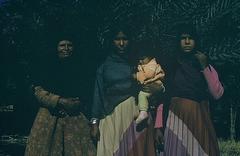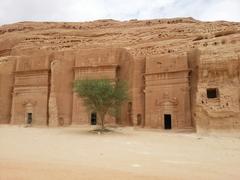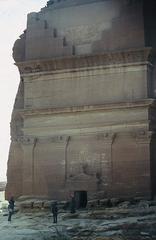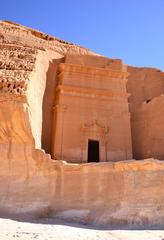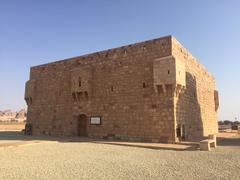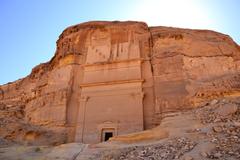Diwan of Jabal Athlab: Visiting Hours, Tickets, and Complete Guide to Medina’s Historical Gem
Date: 15/06/2025
Introduction
The Diwan of Jabal Athlab (ديوان جبل أثلب), carved into the dramatic sandstone cliffs northeast of AlUla, stands as a monumental testament to the ingenuity and cultural sophistication of the ancient Nabataeans. Located near the UNESCO World Heritage site of Madain Saleh (Al-Hijr), this remarkable site invites travelers to experience a unique blend of natural wonder and ancient architecture. This guide provides in-depth insight into Jabal Athlab’s history, cultural significance, practical visiting information—including hours and tickets—and essential travel tips for exploring AlUla’s most treasured archaeological sites. (TravelPander; Madain Project; Leaders MENA)
Table of Contents
- Historical Background
- Visiting Jabal Athlab
- Nearby Attractions
- Visuals and Media
- FAQ
- Travel Tips
- Conclusion and Call to Action
- References
Historical Background
Origins and Nabataean Influence
Jabal Athlab’s story stretches back to the Dadanite and Lihyanite kingdoms (9th–2nd centuries BCE), but its defining features emerged during the Nabataean era (1st century BCE–1st century CE). The Nabataeans, renowned for their mastery of desert trade and hydraulic engineering, extended their civilization from Petra (Jordan) southward to Hegra (Madain Saleh), making Jabal Athlab a significant religious and social hub in their expanding kingdom. (SA-FE)
The Diwan: Architectural and Social Center
At the heart of Jabal Athlab, the Diwan is a grand chamber hewn into the sandstone. Measuring approximately 12 meters deep, 10 meters wide, and 8 meters high, it features an imposing entrance framed by two square columns. Stone benches line three walls, creating a space believed to have hosted royal banquets, political meetings, and religious rituals. The chamber’s exceptional acoustics were ingeniously designed to amplify music and chanting, underscoring the Nabataeans’ architectural prowess. (Madain Project; DestinationKSA)
Religious and Cultural Significance
Jabal Athlab is adorned with Nabataean rock carvings and inscriptions, many of which reference deities such as Dushara and Al-Uzza. The Siq—a narrow, winding passage reminiscent of Petra’s entrance—further highlights the area’s ceremonial importance. Surrounding the Diwan are water channels and cisterns, a testament to Nabataean hydraulic skill and the site’s role in ritual feasting and community gatherings. (SA-FE; DestinationKSA)
Connection to AlUla and Hegra
Jabal Athlab is part of the vibrant archaeological landscape of AlUla. Its proximity to Hegra—renowned for over 130 monumental tombs—and the architectural similarities to Petra underscore the interconnectedness of Nabataean sites. The region’s ancient caravan routes and water management infrastructure further reflect its central role in Arabian history. (TravelPander; MallsRuh)
Legends and Later Associations
Local Islamic tradition connects Jabal Athlab with the story of Prophet Salih and the miraculous she-camel, adding layers of legend to the site’s historical narrative. (MallsRuh)
Visiting Jabal Athlab
Hours and Ticket Information
- Opening Hours: Generally open daily from 8:00 AM to 6:00 PM, but hours may vary seasonally or during events. For the most accurate schedule, consult Experience AlUla or your tour provider.
- Tickets: Entry to Jabal Athlab is typically included with AlUla region heritage passes. Tickets can be purchased online or at visitor centers. Prices and packages vary by season, with discounts for groups and families.
Site Access and Facilities
- Location: About 25 km northeast of AlUla town, accessed via well-maintained roads. The site is reached by car or organized tour.
- Facilities: Onsite amenities are minimal—no restrooms, cafes, or shops—so bring water and snacks. The nearest facilities are in AlUla town.
- Parking: Available near the site, with clear signage in Arabic and English.
Guided Tours
Guided tours are highly recommended to enrich your understanding of the site’s history and symbolism. Tours can be booked through Experience AlUla or authorized operators and may include neighboring attractions such as Hegra, Elephant Rock, and AlUla Old Town.
Accessibility and Safety
- Terrain: Rocky paths and uneven surfaces may challenge visitors with limited mobility. Sturdy footwear is advised.
- Safety: The site is safe and well-patrolled, but visitors should remain on marked paths and avoid exploring after dark. Carry water, sun protection, and a hat, especially in warmer months.
- Emergency: For assistance, dial 999 (police) or 997 (ambulance).
Cultural Etiquette
- Dress modestly, covering shoulders and knees; women are advised to wear an abaya.
- Respect the site by not touching or defacing rock art and inscriptions.
- Photography is permitted but drones require special permission.
- Public displays of affection and alcohol are prohibited.
Best Time to Visit
- Climate: Visit from November to March for mild temperatures (10–23°C/50–73°F).
- Crowds: Cooler months coincide with peak tourism and festivals; for quieter visits, opt for October or April.
Nearby Attractions
- Hegra (Madain Saleh): Saudi Arabia’s first UNESCO World Heritage site, with more than 130 Nabataean tombs.
- AlUla Old Town: A maze of mudbrick houses and ancient streets, offering cultural experiences and traditional dining.
- Elephant Rock: A natural sandstone formation, especially photogenic at sunset.
- Dadan Heritage Trail and Ikmah Mountain: Sites of additional inscriptions and rock art.
Visuals and Media
Capture the grandeur of the Diwan chamber, the intricate rock inscriptions, and the ever-changing desert light. Official AlUla tourism websites offer virtual tours and high-quality images for pre-visit inspiration.
FAQ
Q: What are the opening hours for Jabal Athlab?
A: Typically 8:00 AM to 6:00 PM, but check for seasonal changes.
Q: How do I purchase tickets?
A: Online via Experience AlUla or at ticket offices in AlUla.
Q: Are guided tours available?
A: Yes, and they provide valuable historical context.
Q: Is the site accessible for people with disabilities?
A: Some areas may be challenging; consult tour providers in advance.
Q: Are there restrooms or cafes on site?
A: No, facilities are available in AlUla town.
Travel Tips
- Timing: Visit early morning or late afternoon for the best light and cooler temperatures.
- Hydration: Bring at least 1–2 liters of water per person.
- Dress Code: Modest clothing is required; comfortable shoes are essential.
- Guides: Support the local economy by hiring certified guides.
- Respect: Leave no trace—do not touch carvings or leave litter.
- Booking: Reserve tours and accommodations early during peak season.
- Connectivity: Mobile coverage is good; English is widely spoken in tourist areas.
Conclusion and Call to Action
The Diwan of Jabal Athlab is a profound window into the world of the Nabataeans, combining awe-inspiring architecture, spiritual depth, and stunning landscapes. Whether you are a history enthusiast or a curious traveler, a visit to this site and the broader AlUla region promises an enriching and memorable adventure.
Plan your visit now:
- Check official resources for current hours, tickets, and events.
- Download the Audiala app for digital guides, maps, and insider tips.
- Follow our social media for the latest updates and exclusive content.
Embark on a journey where echoes of ancient Arabia resonate through the sandstone canyons, and let Jabal Athlab’s legacy inspire your exploration of Saudi Arabia’s desert kingdom.
References
- Exploring Jabal Athlab: Visiting Hours, Tickets, and Historical Insights into AlUla’s Nabataean Gem, 2024, (TravelPander)
- Visiting Al Diwan at Jabal Ithlib: Hours, Tickets, and Historical Insights in AlUla, 2024, (Madain Project)
- Visiting the Diwan of Jebel Athleb: Hours, Tickets, and Exploring Al-Ula’s Historic Gem, 2024, (Leaders MENA)
- Jabal Athlab Visiting Hours, Tickets, and Travel Guide to AlUla Historical Sites, 2024, (Experience AlUla)
- The Nabataean Legacy in Saudi Arabia, 2023, (SA-FE)
- Al Diwan Architectural Features and Cultural Significance, 2024, (DestinationKSA)
- Jabal Athlab Diwan: Archaeological and Cultural Insights, 2024, (Sabq)
